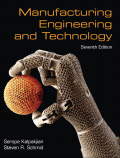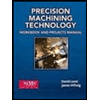
EBK MANUFACTURING ENGINEERING & TECHNOL
7th Edition
ISBN: 8220100793431
Author: KALPAKJIAN
Publisher: PEARSON
expand_more
expand_more
format_list_bulleted
Textbook Question
Chapter 23, Problem 9RQ
Why are turret lathes typically equipped with more than one turret?
Expert Solution & Answer
Want to see the full answer?
Check out a sample textbook solution
Students have asked these similar questions
Your manager has asked you to submit a report based on lead screws and screw jacks on plant premises. You need to include following calculations for the report.
1. The lead screw of a lathe has Acme threads of 50 mm outside diameter and 8 mm pitch. The screw must exert an axial pressure of 2500 N in order to drive the tool carriage. The thrust is carried on a collar 110 mm outside diameter and 55 mm inside diameter and the lead screw rotates at 30 r.p.m. Determine (a) the power required to drive the screw; and (b) the efficiency of the lead screw. Assume a coefficient of friction of 0.15 for the screw and 0.12 for the collar.
2. The lead screw of a lathe has Acme threads of 60 mm outside diameter and 8 mm pitch. It supplies drive to a tool carriage which needs an axial force of 2150 N. A collar bearing with inner and outer radius as 30 mm and 60 mm respectively is provided. The coefficient of friction for the screw threads is 0.12 and for the collar it is 0.10. Find the torque…
What is a tree lathe?
A NC lathe cuts two passes across a cylindrical workpiece under automatic cycle. The operator loads and unloads the machine. The starting diameter of the work is 3.00 in and its length = 10 in. The work cycle consists of the following steps (with element times given in parentheses where applicable):
1 - Operator loads part into machine, starts cycle (1.00 min);
2 - NC lathe positions tool for first pass (0.10 min);
3 - NC lathe turns first pass (time depends on cutting speed);
4 - NC lathe repositions tool for second pass (0.4 min);
5 - NC lathe turns second pass (time depends on cutting speed); and
6 - Operator unloads part and places in tote pan (1.00 min).
In addition, the cutting tool must be periodically changed. This tool change time takes 1.00 min. The feed rate = 0.007 in/rev and the depth of cut for each pass = 0.100 in. The cost of the operator and machine = $39/hr and the tool cost = $2.00/cutting edge. The applicable Taylor tool life equation has parameters: n = 0.26 and…
Chapter 23 Solutions
EBK MANUFACTURING ENGINEERING & TECHNOL
Ch. 23 - Describe the types of machining operations that...Ch. 23 - What is turning? What kind of chips are produced...Ch. 23 - What is the thrust force in turning? What is the...Ch. 23 - What are the components of a lathe?Ch. 23 - (a) What is a tracer lathe? (b) What is an...Ch. 23 - Describe the operations that can be performed on a...Ch. 23 - Why were power chucks developed?Ch. 23 - Explain why operations such as boring on a lathe...Ch. 23 - Why are turret lathes typically equipped with more...Ch. 23 - Describe the differences between boring a...
Ch. 23 - How is drill life determined?Ch. 23 - What is the difference between a conventional...Ch. 23 - Why are reaming operations performed?Ch. 23 - Explain the functions of the saddle on a lathe.Ch. 23 - Describe the relative advantages of (a)...Ch. 23 - Explain how external threads are cut on a lathe.Ch. 23 - Prob. 17RQCh. 23 - Explain the reasoning behind the various design...Ch. 23 - Note that both the terms tool strength and...Ch. 23 - (a) List and explain the factors that contribute...Ch. 23 - Explain why the sequence of drilling, boring, and...Ch. 23 - Why would machining operations be necessary even...Ch. 23 - A highly oxidized and uneven round bar is being...Ch. 23 - Describe the difficulties that may be encountered...Ch. 23 - (a) Does the force or torque in drilling change as...Ch. 23 - Explain the similarities and differences in the...Ch. 23 - Describe the advantages and applications of having...Ch. 23 - Assume that you are asked to perform a boring...Ch. 23 - Explain the reasons for the major trend that has...Ch. 23 - Describe your observations concerning the contents...Ch. 23 - The footnote to Table 23.12 states that as the...Ch. 23 - In modern manufacturing, which types of metal...Ch. 23 - Sketch the tooling marks you would expect if a...Ch. 23 - What concerns would you have in turning a powder...Ch. 23 - The operational severity for reaming is much lower...Ch. 23 - Review Fig. 23.6, and comment on the factors...Ch. 23 - Explain how gun drills remain centered during...Ch. 23 - Comment on the magnitude of the wedge angle on the...Ch. 23 - If inserts are used in a drill bit (see Fig....Ch. 23 - Refer to Fig. 23.11b, and in addition to the tools...Ch. 23 - Calculate the same quantities as in Example 23.1...Ch. 23 - Estimate the machining time required to rough turn...Ch. 23 - A high-strength cast-iron bar 8 in. in diameter is...Ch. 23 - A 0.30-in.-diameter drill is used on a drill press...Ch. 23 - In Example 23.4, assume that the workpiece...Ch. 23 - For the data in Problem 23.45, calculate the power...Ch. 23 - A 6-in.-diameter aluminum cylinder 10 in. in...Ch. 23 - A lathe is set up to machine a taper on a bar...Ch. 23 - Assuming that the coefficient of friction is 0.25,...Ch. 23 - A 3-in.-diameter, gray cast iron cylindrical part...Ch. 23 - Would you consider the machining processes...Ch. 23 - Would it be difficult to use the machining...Ch. 23 - If a bolt breaks in a hole, it typically is...Ch. 23 - An important trend in machining operations is the...Ch. 23 - Review Fig. 23.8d, and explain if it would be...Ch. 23 - Boring bars can be designed with internal damping...Ch. 23 - A large bolt is to be produced from extruded...Ch. 23 - Make a comprehensive table of the process...
Knowledge Booster
Learn more about
Need a deep-dive on the concept behind this application? Look no further. Learn more about this topic, mechanical-engineering and related others by exploring similar questions and additional content below.Similar questions
- Identify the lathe operations in the below mentioned diagram and name and explain them.?arrow_forwardThe end of a large tubular workpart is to be faced on a NC vertical boring mill. The part has an outside diameter of 38.0 in and an inside diameter of 24.0 in. If the facing operation is performed at a rotational speed of 40.0 rev/min, feed of 0.015 in/rev, and depth of cut of 0.180 in, determine (a) the cutting time to complete the facing operation and the cutting speeds and metal removal rates at the beginning and end of the cut.arrow_forwardPlease answer all parts within 30 mins to get a thumbs up! Please show neat and clean work . I will upvote for sure .arrow_forward
- 3. Through hole of 12 mm diameter is to be drilled in a steel plate of 20 mm thickness, drilled spindle speed is 20 m/min, feed 0.25 mm/rev and drill point angle is 120°, the amount of material removed at the first 10 sec after full engagement of drill will be .. (a) 2300, (b) 2400, (c) 2500, (d) 2600, (e) 2700 mm /sec.arrow_forwardIdentify and explain the method of milling process in which the stresses on the teeth is maximum at the end of the cut with neat diagram.arrow_forward2. Through hole of 12 mm diameter is to be drilled in a steel plate of 20 mm thickness, drilled spindle speed is 20 m/min, feed 0.25 mm/rev and drill point angle is 120°, the amount of material removed at the first 10 sec after full engagement of drill will be mm/sec. (a) 2300, (b) 2400, (c) 2500, (d) 2600, (e) 2700arrow_forward
- ENT 152 Computer Aided Manufacturing I Milling Worksheet-SHOW ALL WORK A milling operation is to be performed at 100 sfpm at .005 ipt. A 500" diameter, 4 flute HSs end mill is to be used. The operation is a slot .100" deep across the diagonal of a rectangular part 4 inches wide and 6 inches long. The material is 4140 medium carbon steel (BHN-250). Use a specific HP of 1.2 HP/in/min. Calculate: RPM feed (ipm) feed (ipr) Length of cut Cut time MRR a. c. b. f. HP required at the spindle HP required at the motor (assume the drive system is 809% efficient) C. d. h.arrow_forwardQuestions is on attached picturearrow_forwardIn the lathe machine, the diameter of workpart 35mm is turned at 100 rpm, depth of cut 0.125 mm, length of continuous chip for one revolution of workpart = 60mm, length undeformed chip= 100.53mm, rake angle = 35°, coefficient of friction= 1.5 and resultant cutting force=215.5 N. Calculate: 1- Horizontal cutting force of the tool on the workpart and vertical cutting force required to hold the tool against the work. 2- The forces components applied against the chip by the tool. 3- Velocity of chip relative to the tool and workpart. 4- The percentage of total energy dissipated due to friction along the shear plane, and the friction at the tool-chip interface.arrow_forward
- A twin-spindle drill simultaneously drills one ½-in hole and one ¾" through a 1" wide work piece. Both holes are twist drill with 118° point angles. cutting speed for material is 230 ft/min. The rotation speed of each spindle can be configured individually. The feed rate of both holes must be set to the same value, since both spindles go down at the same speed. The forward speed is set in such a way that the speed total metal removal does not exceed 1.50 in3 /min. Determine: a) the velocity maximum feedrate (in/min) that can be used, b) the individual feedrates (in/rev) that result in each hole and c) the time required to drill the holes.arrow_forwardWrite some of the standard work holding devices used to hold the work in a lathe and with a neat sketch explain any two in detail?arrow_forwardA cylindrical work bar with 4.5 in diameter and 52 in length is chucked in an engine lathe and supported at the opposite end using a live center. A 46.0 in portion of the length is to be turned to a diameter of 4.25 in one pass at a speed of 450 ft/min. The metal removal rate should be 6.75 in3 /min. Determine (a) the required depth of cut, (b) the required feed, and (c) the cutting time.arrow_forward
arrow_back_ios
SEE MORE QUESTIONS
arrow_forward_ios
Recommended textbooks for you
 Precision Machining Technology (MindTap Course Li...Mechanical EngineeringISBN:9781285444543Author:Peter J. Hoffman, Eric S. Hopewell, Brian JanesPublisher:Cengage Learning
Precision Machining Technology (MindTap Course Li...Mechanical EngineeringISBN:9781285444543Author:Peter J. Hoffman, Eric S. Hopewell, Brian JanesPublisher:Cengage Learning

Precision Machining Technology (MindTap Course Li...
Mechanical Engineering
ISBN:9781285444543
Author:Peter J. Hoffman, Eric S. Hopewell, Brian Janes
Publisher:Cengage Learning
HOME SHOP JIGS & FIXTURES PART 1, TYPES OF JIGS & ACCESSORIES AND THE THEORIE BEHIND THE TOOLS; Author: THATLAZYMACHINIST;https://www.youtube.com/watch?v=EXYqi42JimI;License: Standard Youtube License